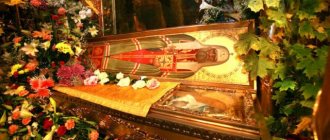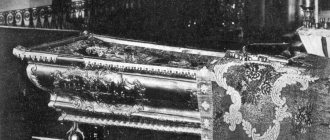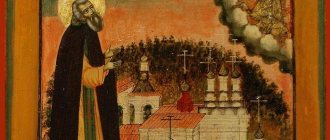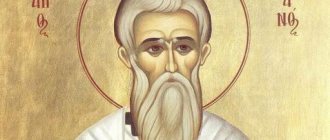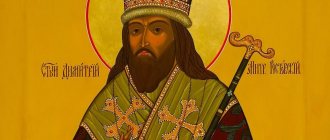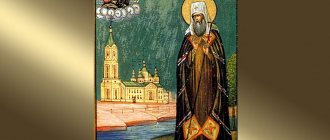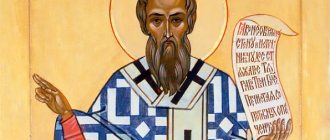| St. Nectarius of Aegina |
Nectarius of Aegina
(1846 - 1920), Metropolitan b. Pentapolis, Saint Commemorated November 9 on the day of death, August 21 (Greek [1]), January 2 (Greek [2]) and in the Councils of the Phthiotis (Greek) and Euboean (Greek) saints
In the world Anastasius Kephalas (Αναστάσιος Κεφάλας), was born on October 1, 1846 in Selivria of Thracia (Σηλυβρία της Θράκης), near Constantinople, in the family of pious parents of Demos (Demosthenes) Kefalas, a sailor by profession, and Vasiliki (Balu) from the Triandaphyllidis family, who besides him had six more children [3]. On January 15, 1847, the three-month-old baby was baptized. Since childhood, I fell in love with the temple, the Holy Scriptures, and learned to pray. The poverty of his parents did not allow him to study at home, and at the age of 14 he left for Constantinople to go to work and pay for his studies.
Life in Constantinople was not easy. The boy first got a job at a tobacco factory, but there was not enough money, and one day, in despair, realizing that there was no one to expect help from, Anastasy decided to make a request to the One whom he loved so much and on Whose help he relied all his life. He wrote a letter to the Lord: “My Christ, I have no apron, no shoes. I ask You to send them to me, You know how much I love You.”
On the envelope he wrote the address: “To the Lord Jesus Christ in heaven” and asked to take the letter to the post office of his neighbor merchant. He, surprised by the unusual signature on the envelope, opened the letter and, seeing such a request and the power of faith, sent the boy money in the name of God.
Then he managed to get a job as a caretaker at a school at the courtyard of the Church of the Holy Sepulchre, where he had the opportunity to continue his education and immerse himself even more deeply in church life.
At the age of 22, Anastasius moved to the island of Chios and began working as a school teacher in the village of Lifi. Here he not only teaches, but also preaches. His influence on his students was such that they, and through them all adults, soon developed love and deep respect for him. He created a wonderful choir from his students and sang with them in a rural church, but his soul was drawn to monasticism.
In 1873 he became a novice in the famous monastery of Nea Moni (New Monastery). On November 7, 1876, he took monastic vows with the name Lazarus and received the obedience of secretary.
On January 15, 1877, he was ordained to the rank of deacon with the name Nektarios, which means “immortal.” The ordination of Saints Minas, Victor and Vincent in the Cathedral was performed by Metropolitan Gregory of Chios.
On Chios he studied at the island's famous gymnasium (corresponding to the modern lyceum). Due to the earthquake that occurred on the island on March 22, 1881, he received his certificate not there, but at the Athens Lyceum of I. Varvakios on November 4, 1881.
On November 13, 1885, he graduated from the Faculty of Theology in Athens, and at the same time the Patriarch of Alexandria Sophronius (Meidantsoglu) brought him closer to him.
On March 23, 1886, he was ordained hieromonk by Patriarch Sophrony at the Alexandria Savvinsky Monastery.
On August 6 of the same year he was elevated to the rank of archimandrite in the Cairo Church of St. Nicholas. Appointed preacher and patriarchal secretary, and then patriarchal governor in the city of Cairo. With zeal and selflessness, he accepted his new obedience and appointment and for his zeal received the title of Supreme Archimandrite of the Alexandrian Church.
| Nektarios (Kefalas), Metropolitan of Pentapolis. Photo 1889-1890 |
On January 2, 1889, he was elected, and on January 15 of the same year, he was consecrated Bishop of Pentapolis and elevated to the rank of Metropolitan.
The consecration was led by Patriarch Sophronius of Alexandria, concelebrating with him were the bishops - former Bishop Anthony of Kerkyra (Hariatis) and Bishop Porfiry of Sinai and Raifa (Marudas) [4]. Episcopal dignity did not change Nektarios’ lifestyle and behavior in any way. However, the rapid rise, the love of the patriarch and the people, and the even more virtuous and pure life of the saint aroused envy and hatred in many. Influential people of the patriarchal court feared that universal love for the saint would lead him to be among the contenders for the place of Patriarch of Alexandria, since Sophrony was already in old age. They slandered the saint, accusing him not only of encroaching on the patriarchate, but also of immoral life.
On May 3, 1890, Saint Nektarios was removed from the post of patriarchal locum tenens, and two months later he was expelled from the Patriarchate with a letter of release:
«
Our unworthiness with this patriarchal letter of dismissal declares that the bearer of this, His Grace Metropolitan of the glorious Pentapolis diocese, Vladyka Nektarios Kephalas, who did not live well in the climate of Egypt, is sent to other lands and is called upon to fulfill his hierarchal duties, wherever he is, with the permission of local church authorities. In confirmation of this, this letter of release is issued for presentation in all necessary cases, Alexandria, July 11, 1890 Patriarch of Alexandria Sophronius
«.
He didn't try to make excuses or defend himself. In August 1890 he arrived in Greece. Hostility followed him like a shadow in Athens. He went through the authorities in vain; they didn’t want to accept him anywhere.
One day, having once again accepted a refusal from the Ministry of Religious Affairs, the saint descended the stairs with tears in his eyes. Seeing him in this state, the mayor of the city spoke to him. Having learned about the plight in which Nectarius was, the mayor secured a position as a preacher for him. On February 14, 1891, he took the place of a simple preacher in the province of Euboea and remained in this post until September 1893, when he was transferred to the region of Phthiotis.
The love of the people accompanied Nectarius. But until the end of his life he had to bear the cross of exile and the name of a disgraced metropolitan who did not belong to any autocephalous Church. He was forced to be in an incomprehensible canonical position, signing all his papers as a “ travelling bishop”
«.
Gradually, the darkness of slander receded from the name of the disgraced saint. People, seeing his pure and virtuous life, listening to his inspired sermons, strove for him. The glory of the Pentapolis Metropolitan from the provinces soon reached the capital and the Greek royal palace. Queen Olga, having met him, soon became his spiritual daughter. Thanks to her, on March 13, 1894, he was appointed director of the Risari Theological School in Athens. The theological school trained clergy and secular church personnel. During the reign of the saint, the school experienced years of growth.
| St. Nectarius of Aegina |
In July 1898, during the school holidays, Fr.
Nektarios visited Athos for the first time. Within a month, he visited the main monasteries of Mount Athos and talked with many elders, and with some of them, such as Daniel of Katunaksky, Jerome of Simonopetra and Savva the New Kalymnos, he was subsequently connected by personal friendship [5]. By this time, his spiritual children began to gather around Nektarios, many went to him for advice and blessing. It was then that the gifts of God’s grace began to manifest themselves in the elder saint: insight, the gift of healing.
Among the numerous spiritual children, several girls gathered near the Vladyka, wanting to devote themselves to the monastic life, but who did not dare to go to any monastery, so as not to lose the spiritual guidance of their mentor. Like a good shepherd, taking care of them, Nektarios began to look for a suitable place and stopped his search on the island of Aegina, which he visited from September 2 to 10, 1904. Having found the ruins of an ancient monastery here, he buys this land with his own funds. The first nuns come here. This is how the Trinity Monastery for women arose on Aegina.
The saint predicted to his novices that their monastery would be rich if they worked hard. The entire life of the new monastery took place under the leadership of Saint Nektarios, with whom the sisters maintained constant correspondence. What fatherly love, care and tenderness his letters are filled with. For some time, the saint simultaneously led the school, while staying in Athens, and his newly built monastery.
At the beginning of 1908, Metropolitan. Nektary suffered a serious illness, after which he decided to resign from his post and on February 7, 1908 he wrote a letter of resignation from the position of school director, which was accepted on April 16, 1908.
On April 20, 1908, he moved to the island of Aegina. On June 23 of the same year, he consecrated the Holy Trinity Monastery, in the reconstruction of which he took an active part. From that moment on, for twelve years, he constantly lived in a one-story house outside the monastery walls, built through his efforts “ in this harsh and waterless place.”
“, and worked, physically and spiritually helping the formation and further activities of the monastery.
He spent the last twelve years of his life with his nuns, raising them for the Heavenly Kingdom. They had to endure many sorrows and temptations, but these were also years of grace. During this time, the monastery was put in order and the economy was organized.
| St. Nectarius of Aegina. Russian icon on canvas, XX century. |
Towards the end of his life, another blow fell on the Saint.
18-year-old Maria Kuda came to the monastery after escaping from her oppressive mother-candlemaker. Saint Nektarios accepted her into the monastery. Then the girl’s mother filed a complaint against the saint, accusing him of seducing girls and killing the babies they allegedly gave birth to. The investigator, who arrived at the monastery, called the saint a centaur and pulled the elder by the beard, and he humbly answered him and himself prepared food for the offender, forbidding the nuns to cry and murmur. The girl was examined by a doctor and confirmed her cleanliness; Of course, the “killed” babies were not found either. After this, the girl’s mother went crazy, and the investigator became seriously ill and came to ask the saint for forgiveness. Feeling his death approaching, he prayed that the Lord would extend the time limit for completing all the work in the monastery, but as he had done all his life, he humbly added: “Thy will be done!” The long-hidden disease has finally taken its toll. In September 1920, he, accompanied by two nuns, was sent to the Areteion (Areteo) Hospital in Athens. Looking at the little old man dressed in a cassock, who was suffering from terrible pain, the employee on duty asked: “Is he a monk?” “No,” answered the nun, “he is a bishop.” “For the first time I see a bishop without a panagia, a golden cross, and most importantly, without money,” the employee noted.
He didn't stay in the hospital long; he was diagnosed with prostate cancer. The saint was placed in a third-rate ward for incurable patients. He spent two months in torment, without ceasing to praise God and thank Him.
Miracles also happened in the hospital; the nurses noticed that the bandages with which they tied the wounds of the Saint were fragrant. A paralyzed man lay in the room with the saint, and when the saint’s soul left this world, he received complete healing through the shirt of Saint Nektarios.
He died on November 8, 1920, Sunday, at 22:30, on the day of the celebration of the Council of the Archangel Michael and other disembodied Heavenly Powers, having received the Holy Mysteries of Christ.
Biography of Saint Nektarios of Aegina
The life of Saint Saint Aegina was not easy; he had to go through the path of a factory worker, a school teacher, a monk, a bishop, endure years of disgrace and exile, and at the end of his life he founded a nunnery. Despite numerous hardships, slander from envious people and ill-wishers, Nectarius of Aegina retained his conscience and faith.
Origin and childhood
In October 1846, a boy, Anastasius Kefalas, was born in Selymbria near Constantinople. He grew up in a poor, large family, but did not experience a lack of parental love and care. Father Dimos Kefalas and mother Vasilika were pious people, they taught children prayers and instilled an interest in spiritual books. Anastasius was fifth among them.
A diligent, understanding boy willingly listened to sermons in church, took notes, and enthusiastically read lives. As he got older, he thought about getting a theological education, but due to lack of money, his parents could not help him.
Life in Constantinople
Having received his primary school education, Anastasy toiled in his native place. When he turned 14, he persuaded the captain, who was preparing to sail to Constantinople, to take him with him. In a big city, a young man got a job as a worker in a tobacco factory. They paid little, the salary covered only minimal needs. Regular prayers did not allow the young man to despair.
Tired of his half-starved life, Anastasius decided to write a letter to the Almighty. He carefully described his misfortunes, and on the envelope he indicated “To Heaven, to the Lord Christ.”
The merchant agreed to send the letter, taking pity on the poor boy with bare feet. At first the man did not pay attention to what was written on the envelope, and when he saw who the recipient was, he became even more sorry. He wrote a response letter on behalf of Christ and sent financial assistance to the young man.
After some time, Anastasy got a job as a school caretaker at the Church of the Holy Sepulchre. The position allowed me to continue my education.
Later, the future Saint of Aegina was accepted as a teacher at a school in the village of Lifi, on the island of Chios. He worked there for several years, not only taught, but also read sermons, and gathered a children's church choir to perform in the village church.
In 1866, during a sea voyage to his homeland, to his parents, Anastasy almost died. The storm almost broke the ship's mast. While the sea was raging, the young man frantically prayed for salvation. The ship safely reached its home shore. This incident, as well as successful church activities, made Anastasia think about a monastic future.
Monasticism
In 1875, Anastasius Kefalas, having passed the test of temptation, took monastic vows at the Neo Moni monastery. Having become a monk Lazar, he observed obedience, working as a monastic secretary.
In 1877, the novice was tonsured into the robe. The future saint received the name Nektarios and the rank of hierodeacon.
Study at the University of Athens
A wealthy benefactor brought the monk together with the Patriarch of Alexandria. With the latter's blessing, Nektarios began to study at the theological faculty of the University of Athens. Completed his studies in 1885.
Next, Nektarios headed to Alexandria, where he hoped, with the support of the patriarch, to gain spiritual exaltation. In the spring of 1886, the ordained priest Nektarios began serving in the Cathedral of St. Sava. He soon received the rank of archimandrite. For a short time he was a member of the Patriarchal Secretariat, then was transferred as a patriarchal representative to Cairo.
Bishop of Pentapolis
In the winter of 1889, Saint Nektarios received the episcopal title. The new Bishop of Pentapolis, respected by the patriarch, adored by the believers, quickly climbing to the top of the church hierarchy, became the object of hatred of envious people. Authoritative representatives of the church, aiming for the patriarchal throne, were worried that Nektarios would take the place of the elderly Patriarch Sophrony.
Envious people slandered the bishop and accused him of immorality. The pressure was so strong that in 1890 Nektary was forced to leave the department. He was no longer allowed to visit populated areas under patriarchal patronage, but was allowed to live in government housing, eat with priests, and conduct religious services. The pressure did not ease, and Nectarius humbly left Egypt.
Before leaving, the bishop was given a letter of gratitude, which was signed by more than 900 parishioners. They lamented what had happened and asked to pray for them.
Saint Nektarios moved to Athens, but even there his enemies did not leave him behind. Trying to find any job in education, he wandered around the authorities, but everywhere his requests were ignored.
One day, after yet another humiliating and fruitless visit to the Minister of Religious Affairs, the saint, weeping bitterly, descended the stairs of the ministry. The city mayor saw him and called out to him. Nektarios told the official about his misfortune, who, indignant at the injustice, contributed to the appointment of the saint to the post of preacher on the island of Euboea.
Serving God
The congregation loved the understanding and kind-hearted preacher. But Saint Nektarios remained an exile, not accepted by the patriarchy. He could not clearly name his position; the documents were signed as “wandering bishop.”
Over the years, the dirty accusations began to be forgotten. The Greek queen Olga Konstantinovna learned about the expelled bishop, talked with him, soon made him her confessor, and contributed to his appointment as the head of the Athens Risarian School of Theology. Here Saint Nektarios worked from 1894 to 1908, doing a lot for the prosperity of the institution.
One day the janitor of the theological school fell ill. When he went back to work after recovery, he thought that he would be fired. But he was surprised to learn that Nektary had been cleaning for him all these days.
Gradually a circle of spiritual children began to form around the saint. During this same period, the shepherd’s ability to heal manifested itself.
Among the followers there were many girls who decided to devote their lives to monasticism, but did not want to part with their spiritual teacher. Then Nektariy conceived the construction of a nunnery. With the money he had accumulated throughout his life, the saint bought a plot of land with ancient monastery ruins on the island of Aegina. This is how the Aegina Trinity Monastery appeared.
Monastic life flowed under the sensitive guidance of the saint. At first, Nectarius of Aegina continued to lead the Athenian school and communicated with the nuns through letters. But when old age took away his strength, the saint retired and moved to Aegina.
One day, a frightened 18-year-old girl came running to the saint’s monastery. It turned out that her cruel mother abused her. Nectarios of Aegina received her at the monastery. The girl's mother complained to the law enforcement officers about the monastery, allegedly girls were seduced there, and babies born in sin were killed.
An investigator arrived at the monastery. He behaved unprofessionally and unethically; during the interrogation he called the saint names and pulled his beard. Nectarios of Aegina remained calm and humble, calming the frightened and crying nuns. The runaway girl was checked by a gynecologist and confirmed her virginity. Later it turned out that the slanderous mother was mentally ill, and the investigator asked the saint for forgiveness.
Nektarios of Aegina spent the last 12 years of his life in the monastery.
Demise
Saint Nektarios of Aegina suffered from cancer for a long time and did not talk about it. When the pain became unbearable at an advanced stage, Nektarios ended up in a hospital in Athens. Treatment required a lot of money, but the monastery did not have it. The elder was sent to the department for terminally ill patients and assigned to a ward for the poor.
When the doctor saw the old man brought, dry, in a shabby race, he asked the accompanying nun who this monk was. The woman replied that this was the Bishop of Aegina. The doctor replied in surprise that it was the first time he had seen the bishop without a gilded robe.
Saint Aegina suffered for two months. He died on November 22, the day of the Archangel Michael. And immediately the first miraculous healing happened. The shirt taken from the deceased was thrown onto the bed of a paralyzed patient lying next to him, who was immediately healed and jumped to his feet.
The body of St. Aegina became clogged with myrrh, so much so that the world had to be removed with cotton wool. All the inhabitants of the island saw off the abbot on his last journey. And after 41 days, Nektarios of Aegina was acquitted by the Patriarch of Constantinople and recognized as a Greek saint.
The meaning of prayer and history
According to church leaders, the origins of Eastern Christianity were laid in Greece, where the great Greek saint Nectarios of Aegina came from.
In the second half of the 19th century, a boy was born in one poor family, who was named Anastasy. Anastasy came from a large family and had five brothers and sisters. The boy was raised by pious parents. The family often visited the temple and attended services, reading prayers to the Savior, the Mother of God and the holy great martyrs.
From early childhood, Anastasy was drawn to knowledge and science, but his parents did not have the money to give their son a good education. In 1876 he began to serve the Lord God. The monk was given a new name - Nectarius.
The monk, who received the patronage of the patriarch himself, studied at the theological faculty in Athens. Over time, Nektarios’s career as a clergyman began to rapidly rise: from receiving the rank of Supreme Archimandrite to being ordained as a metropolitan in Cairo. The last event occurred in 1889. Such a rapid rise gave rise to anger and envy among other clergy. Following a false denunciation, Metropolitan Nektarios of Aegina was demoted from office and sent back to Greece.
Not daring to confront fate and refute false slander, Nektarios endured poverty and deprivation, often having neither food nor decent clothing. Thanks to the intercession of pious Christians, the holy martyr received a position as a preacher, a roof over his head and the means to live.
At the beginning of the twentieth century, the elder decided to found a convent in an abandoned monastery on the island of Aegina. For many years, he was engaged in improving the area and creating a shrine, taking care of the poor and his spiritual children.
The elder died in an ordinary hospital, surrounded by poor and disadvantaged Christians. Experiencing severe pain and suffering, Nektarios pronounced words of gratitude to Jesus Christ and His grace. The clothes of the deceased old man accidentally ended up on the neighboring bed of a paralyzed beggar. A miracle happened: the weak patient rose to his feet and gained strength.
Orthodox Christians, turning to the saints in their prayers, note that faith in Nectarios of Aegina works miracles. Heeding the prayers and petitions of believers, the Saint bestows enlightenment and peace of mind, restores weakened faith and directs them to the true path. In their prayers addressed to God’s saint Nectarius of Aegina, they ask for help:
- when making the correct diagnosis and choosing the right treatment method;
- in the fight against various ailments, including cancer;
- for diseases of a neurological nature that have a detrimental effect on the patient;
- to improve weather and climate conditions and prevent various disasters.
Today, the relics of Nektarios of Aegina are in the Trinity Monastery, the restoration of which was carried out by the Saint during his lifetime. When permission was issued for the reburial of the deceased, Orthodox Christians discovered that the body of the saint of God remained incorrupt. And even the flowers that were laid by followers and disciples on the grave of the Most Holy Nektarios remained fresh and fragrant for a long period.
Creative heritage
During his long life, full of difficulties, Saint Saint Aegina wrote several theological works:
- "The Work of the Church";
- “On the One Holy Catholic and Apostolic Church”;
- “The Credibility and Authority of the Church”;
- “About the Kingdom of God or the Church.”
Saint Nektarios of Aegina created the most widespread temple hymn in Greece, “Holy Virgin, Rejoice.” The saint also left numerous teachings to humanity - brief but succinct expressions with deep worldly wisdom.
Prayers
Troparion, tone 4
Having lived a venerable life, like a wise hierarch,/ you glorified the Lord with your virtuous life,/ Nectarios of the Reverend./ Moreover, you glorified the Comforter with strength,/ with your divine powers,/ demons from you persecute and heal the sick, // those who come by faith.
Troparion, Hellenic, voice 1
(translation by Natalia Bakhareva)
Silivria the seed and Aegina the observer, / revealed in new times, / the virtues of a sincere friend, / We honor Nectarios, faithful, / as the divine servant of Christ. / Exudes many healings honorable to those who cry piously:/ glory to Christ who glorified you,/ glory to him who surprised you,// Glory to the one who works for you to heal everyone.
Hellenic Kontakion, tone 8
(translation by Natalia Bakhareva)
Orthodoxy’s new-bright star/ and the Church’s newly-created protection,/ let us sing in joyful hearts:/ glorified by the action of the Spirit,/ exuding healings, unenvious grace to those crying out to you // Rejoice, O Oh, Nektarios.
